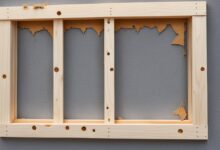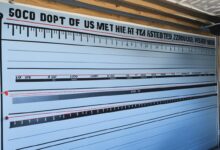How Many Jack Studs for Header
How Many Jack Studs for Header : When framing and constructing a header, figuring out how many jack studs you need is key. Jack studs,

How Many Jack Studs for Header : When framing and constructing a header, figuring out how many jack studs you need is key. Jack studs, also known as trimmer studs, are crucial for support and stability. The right number depends on the opening’s width, the load it must carry, and local building rules. This guide will help you understand how to pick the right number of jack studs for your project.

Key Takeaways
- The number of jack studs required for a header depends on the width of the opening, the load-bearing needs, and local building codes.
- Properly installed jack studs provide critical structural support and stability for the header.
- Double jack studs may be necessary for wider openings or higher load-bearing requirements.
- Understanding the purpose and placement of jack studs is essential for ensuring a secure and code-compliant header installation.
- Consulting with a professional or referring to span tables can help determine the appropriate number of jack studs for your specific project.
Understanding Jack Studs and Headers
In construction framing, jack studs and headers are key for a building’s strength and stability. They work together to support and spread loads across openings. This makes the foundation safe and secure.
What are Jack Studs?
Jack studs are vertical pieces that sit under a header. They support and stabilize the structure. These framing jack studs carry the weight of the header and any loads above it down to the foundation.
They work with king studs, which go from the floor to the top of the wall. Together, they form a strong framework. This is vital for the header to work right.
The Purpose of Headers
Headers are horizontal pieces that go over openings like doors and windows. They spread out the weight and loads above the opening. This keeps the wall stable and whole.
Headers can be made of different materials like solid wood, engineered wood, or steel. The choice depends on the opening size, the loads it needs to hold, and the project’s needs.
Jack studs and headers together make a strong framing system. This is key for a building’s structural soundness. Knowing how these parts work is important for any building project.
“The proper installation and placement of jack studs and headers is critical for the overall stability and safety of a structure.”
Determining the Number of Jack Studs Required
Choosing the right number of jack studs is key for a strong, load-bearing header. The number needed depends on the opening’s width, the load it must carry, and local building codes.
Factors Influencing Jack Stud Requirements
Several factors affect how many jack studs you’ll need:
- Opening Width: A wider opening means more jack studs are needed for support. For instance, a 5-foot opening might need more studs than a 3-foot one.
- Load-Bearing Capacity: The weight the header must hold, like from the roof or upper floors, affects the number of studs. This ensures the structure stays strong.
- Building Codes: Local building codes set a minimum number of jack studs. This depends on the opening size and load requirements.
Think about these factors to figure out the right number of jack studs for your project. This ensures your header is both strong and meets building codes.
Remember, while guidelines and span tables are helpful, your project might have unique needs. Talking to a local building inspector or a professional can help you meet all the code requirements. This ensures your structure is safe and sturdy.
Jack Stud Size and Specifications
In construction framing, the size and specs of jack studs are key for a building’s strength. Jack studs support headers, making sure the building is strong and safe.
Jack studs usually come in sizes from 2×4 to 2×12, with 2×4 and 2×6 being the most common. The right size depends on the header’s span, the load it needs to hold, and local building rules.
| Jack Stud Size | Typical Applications |
|---|---|
| 2×4 | Lightweight, non-load-bearing headers, such as interior walls or small openings |
| 2×6 | Moderate-load bearing headers, such as exterior walls or larger openings |
| 2×8 to 2×12 | Heavy-duty, load-bearing headers, such as garage doors, large window openings, or structural beams |
The type of wood for jack studs matters too. Softwoods like Douglas Fir, Southern Yellow Pine, or Spruce-Pine-Fir (SPF) are often used. They’re strong, easy to find, and not too expensive. These woods are graded for strength, with No. 2 or No. 3 being most common in framing.
Choosing the right jack stud size is important. Talk to your local building codes, a structural engineer, or a contractor to get the best size for your project. They’ll make sure your build is safe and lasts a long time.
How Many Jack Studs for Header
When framing a header, the number of jack studs you need can change based on several things. It’s key to know how many jack studs you should use to keep your construction safe and strong. We’ll look at how to figure out the right number of jack studs for different header sizes and opening widths.
Recommended Jack Stud Quantities
The rule is, the wider the opening, the more jack studs you’ll need. This helps spread out the weight of the header evenly. Here are some tips:
- For openings up to 4 feet wide, you usually need at least 2 jack studs, one at each end.
- For openings between 4 and 6 feet wide, you’ll need 3 jack studs, one at each end and one in the middle.
- For openings between 6 and 8 feet wide, you’ll need 4 jack studs, with one at each end and two in the middle.
- For openings wider than 8 feet, you might need more jack studs or even a double header system for extra support.
Remember, these are basic rules, and the actual number of jack studs you’ll need can change. This depends on the header size, the weight it must hold, and local building codes. Always check with a pro or your local building codes to make sure you’re following the rules and providing enough support.
Visualizing Jack Stud Placement

The image above shows how jack studs are usually placed with the header and opening width. Knowing this helps you plan and do your framing work right, making sure the header is well-supported and your structure is safe.
The exact number of jack studs you need for a header depends on your specific project. By using industry standards and best practices, you can make sure your header is strong and can handle the loads it will face.
Double Jack Stud Installation
Sometimes, a single jack stud isn’t enough for headers, especially for wide openings or heavy loads. That’s when double jack studs are needed to make sure the structure stays stable and strong.
When to Use Double Jack Studs
Here are the main times to use double jack studs:
- Openings wider than 4 feet: For large windows or sliding doors, double jack studs help prevent sagging and structural problems.
- High load-bearing applications: They’re great for areas with heavy loads, like above garage doors or big entry ways, to spread the weight out better.
- Structural reinforcement: In buildings with special designs or extra load needs, double jack studs add extra support to the header.
Putting in double jack studs the right way is key for them to work well. Let’s look at the important steps to follow.
Proper Installation Techniques
Here’s how to install double jack studs right:
- Measure the opening: Measure the header opening’s width to figure out how many double jack studs you need.
- Prepare the framing: Make sure the wall framing is strong and lined up right for the double jack studs.
- Position the jack studs: Put the double jack studs on both sides of the header, making sure they’re straight and securely attached to the top and bottom plates.
- Secure the header: Use the right fasteners, like nails or screws, to attach the header to the double jack studs for a strong connection.
- Inspect and reinforce: Check the installation carefully and add extra support, like blocking or shims, to make sure it can handle the load.
By doing it this way, you make sure your header gets the support it needs. This makes your project stronger and more stable.
Jack and King Stud Framing Techniques
Building a strong framing system is key for any project. Jack and king studs are crucial for this. Let’s look at how to place, space, and secure these framing parts right.
Positioning Jack Studs
Jack studs sit right under the header, giving it support. They must be lined up perfectly for stability. It’s also important to space them correctly to spread the load evenly.
Fastening the Jack Studs
It’s vital to attach jack studs well to the header and wall plate. Use nails, screws, or metal fasteners as needed. Make sure the fasteners are strong enough for the job.
Integrating King Studs
King studs go from the wall plate to the top, adding more support. They sit on either side of the header. Getting them in the right spot and securing them well makes the framing strong and unified.
Using jack and king stud framing best practices helps ensure the header is supported well. This is key for a strong and lasting structure. Knowing these methods is crucial for top-notch building projects.

“Proper framing techniques for jack and king studs are the foundation of a strong, load-bearing header.”
Load-Bearing Headers and Jack Stud Requirements
Load-bearing headers and jack studs are key to a strong and reliable structure. They work together to keep the building stable and transfer weight to the foundation. This is crucial for the structure’s safety.
Understanding Load Calculations
Getting the right load calculations is vital for figuring out how many jack studs you need for load-bearing headers. Engineers look at the roof, walls, and any extra loads to find out how much weight the header must handle. Then, they use this info to decide on the size and number of jack studs needed.
It’s important to get the load-bearing capacity of a header right. If you guess too low, the structure might fail. Guessing too high means spending more money than needed. Always talk to experienced engineers to make sure your load calculations and jack studs are correct.
| Load Factor | Description | Considerations |
|---|---|---|
| Dead Load | The weight of the building’s permanent parts, like walls, floors, and the roof. | Knowing the exact weight of the materials is key to figuring out the dead load. |
| Live Load | The weight of things that can move, like people and furniture, inside the building. | Live loads change a lot based on how the building is used, so it’s important to think about its purpose. |
| Environmental Loads | Forces from outside, like wind, snow, or earthquakes. | These loads can be hard to estimate because they depend on where the building is and the weather there. |
Knowing about different loads and how they affect the structure helps architects, builders, and engineers. They can make sure the load-bearing headers and jack studs are just right for the project.
“Proper load calculations are the foundation of a structurally sound building. Skimping on this critical step can lead to disastrous consequences down the line.”
Thinking carefully about load calculations and jack stud needs is key for any project with load-bearing headers. By understanding structural engineering and working with experts, builders can make sure their projects stand the test of time.
Span Tables and Building Codes
When figuring out how many jack studs you need for a header, you must look at local building codes and use span tables. These tools give you the info you need to make sure your project meets the required standards.
Span tables are found through building material suppliers or local building departments. They tell you the biggest span a header can have and how many jack studs you’ll need for it. By using these tables, you can figure out the right number of jack studs for your header size and follow local building codes.
Building codes set the lowest standards for construction in a certain area. They say how wide a header can be and what support it needs, like how many and where jack studs should be. It’s important to know and follow your local building codes to get permits and pass inspections.
FAQ
How many jack studs are needed for a header?
The number of jack studs needed depends on the opening’s width, the load it must carry, and local building codes. It’s wise to have at least one jack stud on each side of the header. Add more for wider openings or heavier loads.
What is the appropriate size for jack studs?
Jack studs usually range from 2×4 to 2×6, depending on the project’s needs. Choose based on the header size, load-bearing capacity, and local building codes.
When should I use double jack studs?
Use double jack studs for wider openings or heavy loads. They add extra support and stability to the header, making the framing stronger and more reliable.
How do I calculate the number of jack studs needed for a 10-foot opening?
For a 10-foot opening, the number of jack studs depends on the header size, load requirements, and local codes. Generally, you’ll need at least 3-4 jack studs on each side for good support.
What is the purpose of jack and king studs in framing?
Jack and king studs are key in framing. Jack studs support the header directly. King studs connect the bottom of the header to the floor, spreading the load evenly throughout the frame.
How do I ensure compliance with building codes when selecting jack studs?
To follow building codes, check the span tables and structural engineering guidelines. They give info on the right jack stud size, spacing, and setup for the header size, opening width, and load needs.




